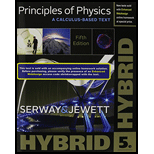
Concept explainers
(a)
The number of carbon atoms in the given sample.
(a)
Answer to Problem 24P
The number of carbon atoms in the given sample is
Explanation of Solution
Write the equation to find the number of carbon atoms.
Here,
Conclusion:
Substitute
Therefore, the number of carbon atoms in the given sample is
(b)
The number of carbon atoms in the given sample.
(b)
Answer to Problem 24P
The number of carbon-14 atoms in the given sample is
Explanation of Solution
Write the equation to find the number of carbon-14 atoms.
Here,
Conclusion:
Substitute
Therefore, the number of carbon-14 atoms in the given sample is
(c)
The decay constant for carbon-14 in inverse seconds.
(c)
Answer to Problem 24P
The decay constant for carbon-14 in inverse seconds is
Explanation of Solution
Write the equation to find the half-life time of carbon-14.
Here,
Conclusion:
Substitute
Therefore, the decay constant for carbon-14 in inverse seconds is
(d)
The number of initial number of decays in a week immediately after the death of species.
(d)
Answer to Problem 24P
The number of initial number of decays in a week immediately after the death of species is
Explanation of Solution
Write the equation to find the decay rate.
Here,
Write the equation to find
Here,
Rewrite the equation for
To find the
Conclusion:
Substitute
Therefore, the number of initial number of decays in a week immediately after the death of species is
(e)
The new number of decays in a week in the current sample.
(e)
Answer to Problem 24P
The new number of decays in a week in the current sample is
Explanation of Solution
Write the equation to find the new number of decays in a week in the current sample.
Here,
Conclusion:
Substitute
Therefore, the new number of decays in a week in the current sample is
(f)
Lifetime of specimen in years using the results from part (c) and (d).
(f)
Answer to Problem 24P
Lifetime of specimen is
Explanation of Solution
Write the equation to find the fraction of decay.
Apply logarithm on both sides.
Rewrite the above equation in terms of
Conclusion:
Substitute
Therefore, the lifetime of specimen is
Want to see more full solutions like this?
Chapter 30 Solutions
Principles of Physics: A Calculus-Based Text, Hybrid (with Enhanced WebAssign Printed Access Card)
- An object is placed 24.1 cm to the left of a diverging lens (f = -6.51 cm). A concave mirror (f= 14.8 cm) is placed 30.2 cm to the right of the lens to form an image of the first image formed by the lens. Find the final image distance, measured relative to the mirror. (b) Is the final image real or virtual? (c) Is the final image upright or inverted with respect to the original object?arrow_forwardConcept Simulation 26.4 provides the option of exploring the ray diagram that applies to this problem. The distance between an object and its image formed by a diverging lens is 5.90 cm. The focal length of the lens is -2.60 cm. Find (a) the image distance and (b) the object distance.arrow_forwardPls help ASAParrow_forward
 Modern PhysicsPhysicsISBN:9781111794378Author:Raymond A. Serway, Clement J. Moses, Curt A. MoyerPublisher:Cengage Learning
Modern PhysicsPhysicsISBN:9781111794378Author:Raymond A. Serway, Clement J. Moses, Curt A. MoyerPublisher:Cengage Learning Principles of Physics: A Calculus-Based TextPhysicsISBN:9781133104261Author:Raymond A. Serway, John W. JewettPublisher:Cengage Learning
Principles of Physics: A Calculus-Based TextPhysicsISBN:9781133104261Author:Raymond A. Serway, John W. JewettPublisher:Cengage Learning College PhysicsPhysicsISBN:9781938168000Author:Paul Peter Urone, Roger HinrichsPublisher:OpenStax College
College PhysicsPhysicsISBN:9781938168000Author:Paul Peter Urone, Roger HinrichsPublisher:OpenStax College Physics for Scientists and Engineers with Modern ...PhysicsISBN:9781337553292Author:Raymond A. Serway, John W. JewettPublisher:Cengage Learning
Physics for Scientists and Engineers with Modern ...PhysicsISBN:9781337553292Author:Raymond A. Serway, John W. JewettPublisher:Cengage Learning College PhysicsPhysicsISBN:9781305952300Author:Raymond A. Serway, Chris VuillePublisher:Cengage Learning
College PhysicsPhysicsISBN:9781305952300Author:Raymond A. Serway, Chris VuillePublisher:Cengage Learning Glencoe Physics: Principles and Problems, Student...PhysicsISBN:9780078807213Author:Paul W. ZitzewitzPublisher:Glencoe/McGraw-Hill
Glencoe Physics: Principles and Problems, Student...PhysicsISBN:9780078807213Author:Paul W. ZitzewitzPublisher:Glencoe/McGraw-Hill





